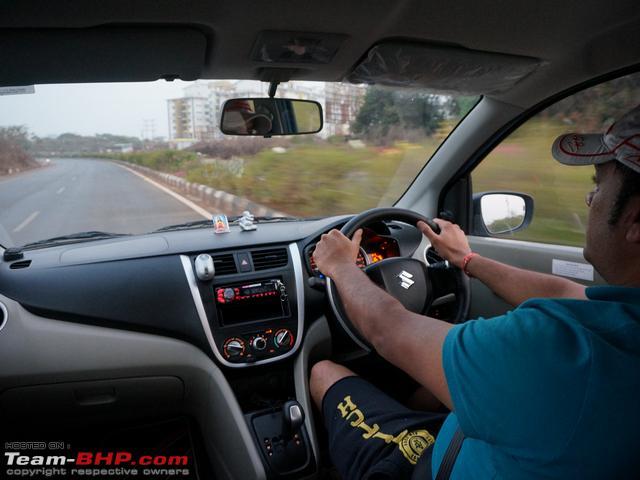News
Advantages & disadvantages of automated driving license tests in India
The automated driving test does not have any scope for testing learner drivers' psychology while driving - and as a result, we are creating selfish road-hogging monster drivers on our roads.
BHPian SS-Traveller recently shared this with other enthusiasts.
About 5 years ago, Delhi started India's first automated driving test track to assess applicants' driving skills in a fair manner before issuing them a permanent driving license, and to weed out corruption in the Regional Transport Offices. On government orders, such automated testing for driving licenses is becoming commonplace in many cities and districts across the country. For those who are unaware of what the automated testing procedure is, here is a detailed video.
The test entails driving forward and in reverse, negotiating a figure-of-eight course, a slalom section, obeying a traffic light, managing to stop and pull away on a mild gradient without rolling back, and parallel parking. Allowances are made for mistakes like hitting a kerb (crossing a yellow line determined to be the kerb by the cameras) multiple times. Yet, a large percentage of applicants fail the automated driving test, and to accommodate and pass more of them, some modifications are being made on the original tracks. This includes a mandatory reminder for examinees to put on their seat belts before starting the test (earlier, those who failed to put on their seat belts before starting off, failed).
What are the advantages of automated DL testing?
According to a survey by SaveLIFE Foundation in India in 2017, it was reported that a whopping 59% of the respondents did not give a test to obtain a driving license.
Multiple research papers have been published [1], [2], [3] listing the advantages of automated DL testing, and include:
- Expediting the testing of candidates aspiring for a driving licence in a more efficient and transparent manner, as compared to manual testing procedure.
- Reduction of time taken to test.
- No dependency on the experience of the examiner in conducting the test.
- No involvement of corruption and/or influence in success or failure of driving test
- Option for examinees to review errors committed by them in driving tests on recorded video, in case of doubt
- Reduction of workload of RTO employees, and ability to test and issue more DLs in a given period of time.
None of the papers, however, list any disadvantages of the automated driver testing system, and it is appalling how many flawed and incompetent drivers the system is producing.
But why is automated DL testing producing flawed and dangerous drivers?
Let us quickly look at what dangers and disadvantages the automated testing procedure entails.
Slow speed driving: Nowhere during the test does the speed of the vehicle exceed 10-15 km/h. While the examinee may well be able to control his vehicle at these speeds (a 3-year-old riding a tricycle can reach such speeds and control his progress), the problems begin when he reaches usual traffic speeds in the city (40-70 km/h), or God forbid, the new and swank expressways (80-120km/h) across the country. At high speeds, the newly licensed driver has no experience or ability to control his vehicle, nor has he ever been tested for this skill. Once he is travelling at high speed on an open road, he does not understand the limits of grip of his tyres or brakes. His license gives him utter freedom to travel at speeds well above the speed limits of a street or highway. During the automated test, the examinee would never have changed from first to second gear. Suddenly, out on the road, he is not able to figure out which gear to be in at what point.
No concept of the dynamics of traffic flow and requirement of crash avoidance space around his vehicle: When tested, the learner driver is benchmarking his position on the road only with relation to static structures such as yellow lines, kerbs, barriers, lampposts etc., which he can pass with inches to spare at a very leisurely pace. He does not understand that overtaking another vehicle and cutting into its path by sharply changing lanes immediately, can result in an unexpected collision; that pulling out of a side road without checking, into the path of an oncoming car, or even a bicycle, endangers human lives; that a vehicle approaching him is actually coming towards him at double or more of the speed he is travelling at, and a collision would be catastrophic; that overtaking a biker with six inches to spare between the two vehicles, or following another car at 100 km/h with 10 metres of space between them, is a sure shot recipe for disaster.
No hazard perception testing: The computerized hazard perception test for learner drivers is a must-do task in many countries, before the learner can even get behind the wheel. However, India, with more than its fair share of hazards on the road for drivers and riders, does not care to test drivers for their ability to recognize hazards on our roads. The grant of a DL after testing the ability to drive around a regulated course with static objects, is producing a genre of drivers who do not look out for pedestrians, wobbly cyclists, and especially loitering animals on our roads.
No knowledge of right-of-way rules and common courtesy for other road users: The automated driving test does not have any scope for testing learner drivers' psychology while driving - and as a result, we are creating selfish road-hogging monster drivers on our roads, leading to ego wars and road rage. The pedestrian and cyclist are not his concern to take care of, and the other car, as long as it is smaller and lower than his own, can be bullied out of the way.
No understanding of the power and acceleration capability of his vehicle: Young drivers and riders, fresh from the exhilaration of having received their new driving licence, begin by driving vehicles that can accelerate to 100 km/h before the driver/rider can utter what on earth is happening? Each driving licence issued empowers the driver to drive vehicles of any engine and performance type, and often these are involved in major crashes on Indian roads. Rules need to be implemented whereby a driver with less than a certain number of years of having received his DL, or those below a certain age, ought to be debarred from driving certain cars and bikes on public roads, that are too powerful for their own good.
No preparation, practice or testing for emergency braking, use of indicators, high & low beams, hazard flashers and fog lamps: The very fact that a majority of drivers driving manual transmission cars in India tend to press the brake and clutch pedals together (I have even noticed some cab drivers do it), means that no one taught these drivers to drive with proper technique. Hardly anyone uses indicators before a turn, lane change, or at a roundabout. As to the use of low beams, the less said the better. Hazard flashers and fog lamps are used indiscriminately and at will, in sunshine, nighttime, rain or fog. Once the DL is received, no one bothers to refine or correct their technique of driving.
No evaluation of setting up and use of rearview mirrors or head checks: Enough said. In a country where half of all drivers keep their ORVMs folded for fear of breakage, how does one know about hazards behind and to the sides? An unaware driver is a dangerous driver.
That the automated driving test is not adequate, has been highlighted in this video.
Listen to the presenter's point of view from 5:53 onwards, to find out.
At the rate India is putting out newer, bigger and more powerful cars on the roads, accompanied by such flawed testing procedures for issuing DLs by the thousands (lakhs?) every day across the country, road safety in India is about to become a topic for more conferences, discussions, hashtags and debates than actual lives being saved. It is high time that DLs are not issued indiscriminately, driver training and testing are made far more stringent, and new traffic rules be brought in whereby drivers would have their licences suspended if involved in a major crash or multiple minor traffic violations (such as, say, 10 traffic light violations), and would need to undergo re-training and re-testing under a completely new and rigorous process before receiving a new DL.
To our experienced drivers on this forum: What are your suggestions for large-scale improvement in the quality of driving and skills of drivers & riders on Indian roads?
Here's what BHPian Samba had to say on the matter:
I agree with all the points you have mentioned. Just like, there is a huge gap between theory and practical, the same applies here. There is a lot of difference in driving inside a confined place and on open roads.
There must be a hands on driving test on the road with moderate traffic where points will be deducted on making every small mistakes. At-least a 15 to 20 mins of drive should be made compulsory. Most of the road users in India has a very pathetic driving sense & that's because no one taught them the right way.
Most of the drivers here learn driving from another senior driver and that driver has learnt in the same manner few years back! So the mistakes are actually been carried forward by the trainers! Even most of the training school drivers are just average drivers with poor knowledge.A child grows up seeing their parents or their trusted driver driving their cars. He/she considers them to be the perfect mentor to learn driving. But no one corrects them the mistakes they pick up from their mentors, & it's been carried forward!
I consider driving to fall under life skill and it should be taken seriously. In India we need proper certified trainers to train the new drivers before appearing for a driving test.
Here people are getting their license through these automated driving license tests, and in reality we need to drive in such conditions!
Here's what BHPian MT_Hyderabad had to say on the matter:
Nothing is perfect in this world and Driving License Testing is no different.
One can argue that the test is conducted in the day, what will happen when it is dark? or even more dangerous - raining!?
Information from National Safety Council states that crashes are more than average during the dark.
Hence, I will continue to believe that there is, and will always remain, some scope of improvement in the testing set up and it can never mimic the real life conditions that one will face in the real world.
Exposure to these conditions during the learning license phase and training is a must.
Here's what BHPian Jeroen had to say on the matter:
So we can’t produce fully automated cars, but we can have fully automated drive testing?
Well, I guess count your blessing in the sense, this is still better than no driving test at all. My driving test in Delhi was a joke. But I agree that this sort of testing is not anywhere sufficient for driving in real traffic.
Here's what BHPian aaargee had to say on the matter:
Sir, I'm of the opinion that, no matter how, where, what one learns, the SYSTEM, the long rotten lack of traffic law enforcement SYSTEM in here, simply turns everyone into another offender.
Although difficult to prove, my opinion is that, it all starts right at schooling; it is indeed the education, the education by Parents, who, for convenience sake, violate all laws to dump their children at school right on time for their fear of their children missing assembly is far greater than traffic violation. And all innocent children get to the notion that, if Parents are doing this, then this must be right.
I can't wait to see how horrendous the situation turns into in next few years when these innocent children turn 18 driving/riding on road.
And why lack of enforcement? I happened to hear one Police lamenting how situation have turned the tables these days; someone recording with a phone, reaching out to social media has strong support towards the offender rather than system of justice. Again the SYSTEM plays a role here.
Check out BHPian comments for more insights and information.














.jpg)





